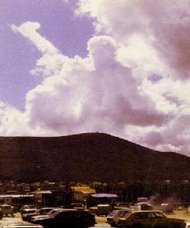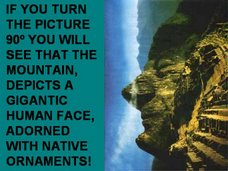The Himalayan Mountains, the highest range on Earth, have been referred to as the "roof of the world." If that is so, there is a mystery called the Yeti in our attic. In Tibetan the word means "magical creature" and truly it is a seemingly supernatural enigma in the shape of a hairy, biped creature that resembles a giant ape.
The Himalayas lie on the border between India, Nepal, and Tibet. They are remote and forbidding. Large stretches around these rough valleys and peaks are uninhabited. The tallest mountain in the world, Everest, 29,028 feet high, lies half in Nepal, half in China. It is from Nepal, though, that most attempts to climb Everest, and the surrounding mountains, are made.
In Kathmandu, the capital of Nepal, a visitor finds himself immersed in the Yeti legend. He is a commercial money maker for the tourist industry (there's even a Hotel named the "Yak and the Yeti") as well as legend, religion and fantasy to some of the Neplaese people.
The first reliable report of the Yeti appeared in 1925 when a Greek photographer, N. A. Tombazi, working as a member of a British geological expedition in the Himalayas, was shown a creature moving in the distance across some lower slopes. The creature was almost a thousand feet away in a narea with an altitude of around 15,000 feet.
"Unquestionably, the figure in outline was exactly like a human being, walking upright and stopping occasionally to uproot or pull at some dwarf rhododendron bushes," said Tombazi, "It showed up dark against the snow and, as far as I could make out wore no clothes."
The creature disappeared before Tombazi could take a photograph and was not seen again. The group was descending, though, and the photographer went out of his way to see the ground were he had spotted the creature. Tombazi found footprints in the snow.
"They were similar in shape to those of a man, but only six to seven inches long by four inches wide at the broadest part of the foot. The marks of five distinct toes and the instep were perfectly clear, but the trace of the heel was indistinct..."
There were 15 prints to be found. Each was one and one half to two feet apart. Then Tombazi lost the trail in thick brush. When the locals were asked to name the beast he'd seen they told him it was a "Kanchenjunga Demon." Tombazi didn't think he'd seen a demon, but he couldn't figure out what the creature was either. Perhaps he'd seen a wandering Buddhist or Hindu ascetic or hermit. As the years went by though and other Yeti stories surfaced, Tombazi began to wonder if he'd seen one too.
Yeti reports usually come in the form of tracks found, pelts offered, shapes seen at a distance, or rarely, actual face-to-face encounters with the creatures. Face to face encounters never come with researchers looking for the Yeti, but with locals who stumble into the creature during their daily lives.
Some of the best tracks ever seen were found and photographed by British mountaineers Eric Shipton and Micheal Ward in 1951. They found them on the southwestern slopes of the Menlung Glacier, which lies between Tibet and Nepal, at an altitude of 20,000 feet. Each print was thirteen inches wide and some eighteen inches long. The tracks seemed fresh and Shipton and Ward followed the trail for a mile before it disappeared in hard ice.
Some scientists that viewed the photographs could not identify the tracks as from any known creature. Others, though, felt it was probably the trail of a languar monkey or red bear. They noted the tracks in snow, melted by the sun, can change shape and grow larger. Even so, the bear/monkey theory seems unlikely as both of these animals normally move on all four feet. The tracks were clearly that of a biped.
Shipton's and Ward's reputations argue against a hoax on their part and the remoteness and height of the trail's location argues against them being hoaxed.
Shipton's footprints were not the first or last discovered by climbers among the Himalayas. Even Sir Edmund Hillary and his Sherpa guide, Tenzing Norgay, on their record ascent to the top of Mount Everest, in 1953, found giant foot prints on the way up.
One of the more curious reports of a close encounter with a Yeti occurred in 1938. Captain d'Auvergue, the curator of the Victoria Memorial in Calcutta, India, was traveling the Himalayas by himself when he became snowblind. As he neared death from exposure he was rescued by a nine foot tall Yeti that nursed him back to health until d'Auvergue was able to return home by himself.
In many other stories, though, the Yeti hasn't been so benign. One Sherpa girl, who was tending her yaks, described being surprised by a large ape-like creature with black and brown hair. It started to drag her off, but seemed to be startled by her screams and let her go. It then savagely killed two of her yaks. She escaped with her life and the incident was reported to the police, who found footprints.
Several expeditions have been organized to track down the Yeti, but none have found more than footprints and questionable artifacts like scalps and hides. The London Daily Mail sent an expedition in 1954. American oil men Tom Slick and F. Kirk Johnson financed trips in 1957, 58, and 59. Probably the most well-known expedition went in 1960.
Sir Edmund Hillary, the same man that had first climbed Everest in 1953, lead the 1960 trip in association with Desmond Doig. The expedition was sponsored by the World Book Encyclopedia and was well outfitted with trip-wire cameras, as well as timelapse and infrared photography. Despite a ten-month stay the group failed to find any convincing evidence of the existence of the Yeti. The artifacts they examined, two skins and a scalp, turned out to belong to two blue bears and a serow goat.
At the time Hillary and Doig wrote off the Yeti as legend. Later, though, Doig decided that the expedition had been too big and clumsy. They didn't see a Yeti, he agreed, but nor did they observe such animals like the snow leopard which was known to exist.
After spending thirty years in the Himalayas Doig believes that the Yeti is actually three animals. The first is what the Sherpas call the "dzu teh." Large shaggy animals that often attack cattle. Diog thinks this is probably the Tibetan blue bear. A creature so rare it is known only in the west through a few skins, bones and a skull. The second type, called "thelma," is probably a gibbon (a known type of ape) that Diog thinks may live as far north as Nepal, though it's never been spotted past the Brahmaputra River in India. The third Yeti, "mih teh," is the true abominable snowman of legend. A savage ape, covered with black or red hair that lives at altitudes of up to 20,000 feet.
So far there is no firm evidence to support the existence of the Yeti, but there is no way show that he doesn't exist either. If he indeed lives in the barren, frozen, upper reaches of the Himalayas where few men dare to tread, he may find his refuge safe for a long time to come.
skip to main |
skip to sidebar




--------------------------------------------------

--------------------------------------------------


-------------------------------------------------

2007 - Tatui-Sao Paulo, Brazil

2007 - Big Basin, California

2004 - Long Island, New York

2001 - Foster City, California

1995 - Kazakhstan, Russia

1993 - Ochre Point, Southern Australia

1992 - Pueblo, Mexico

1989 - Nashville, Tennessee

1982 - Switzerland
# MASKED PRISONER # DINOSAURS # RIPPER # ALIENS # HUMAN COMBUSTION # GIANT LIZARD # BURIAL PLACE OF GHENGIS # PHILOSOPHER'S STONE # REINCARNATION # POLTERGEIST # HAUNTED CASTLES # MIGRATION # KING ARTHUR # DEATH WORM # BERMUDA TRIANGLE # DEVIL # GHOSTS # DRAGONS # YETI # UFOS # NOSTRADAMUS # LEVITATION # NOAH'S ARK # DRAGON'S TRIANGLE # SASQUATCH # GHOST OF BREGAVY # GIANT CHIMPS # "NTIKYTHERA # STONEHENGE # ATLANTIS # MONSTER OF THE AMAZON # PHANTOM # GHOSTS # MONSTERS
Facebook Badge
Labels
- 'THE NATIONAL' ABU DHABI AND 'THE TRIBUNE' NORTH INDIA (1)
- "CITY AUTHOR PENS RECORD" - SHARING THE NEWS ITEM WHICH WAS PUBLISHED IN YESTERDAY'S 'DAINIK JAGRAN' NEWSPAPER ('CITY PLUS' SUPPLEMENT) (1)
- 2013 (1)
- 2015 (2)
- A Link between Egypt and Americas? (1)
- a record book published by Coca Cola India (1)
- Aliens love oceans (1)
- An article about my five books...published in eight months... (1)
- An Excerpt From My Book: "A Matter Of Survival" (1)
- and first political crime thriller) (1)
- Another newspaper story about my career as an author (1)
- Article about me: "Writing a new chapter at 50 plus"... (1)
- Article about my books and me in the national daily The Hindustan Times (1)
- ARTICLE ABOUT MY FIVE BOOKS IN THE TIMES OF INDIA (1)
- ARTICLES ABOUT MY BOOKS IN 'GULF NEWS' DUBAI (1)
- as author with most books on crime fiction in shortest time (1)
- AT THE TIMES GROUP BOOKS STALL...DELHI WORLD BOOK FAIR 2013...WITH TWO OF MY BOOKS (1)
- Atlantis - The Lost Continent (1)
- caught on camera (1)
- Cleopatra died of drug-spiked cocktail (1)
- Colorado (1)
- Did Napoleon die from poisoning? (1)
- Dragons - Myth Or Reality? (1)
- Easter Island's Walking Stones (1)
- Eight book reviews of my new novel "Chief Minister's Mistress"..... (1)
- Extinction of dinosaurs (1)
- Famous American Ghosts... (1)
- Featuring for two consecutive years in the Limca Book of Records (2012 and 2013) (1)
- Ghosts (1)
- Giant Chimps Of The Magic Forest (1)
- Haunted Scottish Castles (1)
- I feature in the Forbes 2014 list of Top 100 Celebrity Indian Authors (1)
- indicate Russian Navy UFO records (1)
- Interview in Spectral Hues.....September (1)
- King Arthur - real or a figmant of imagination? (1)
- Levitation (1)
- Loch Ness Monster 'caught on camera' off British coast (1)
- My Author's Corner event at the Delhi World Book Fair (1)
- My first book... (1)
- My fourth book (1)
- My interview in 'Suburb'.....September (1)
- My new book (my 16th release (1)
- My second novel: "The Inheritance" has been published (1)
- My three books (1)
- MY WEBSITE (1)
- Mystery of the Lizard Man (1)
- National Record Certificate: 2014.....Fastest published crime fiction author of India (fourth year in a row) (1)
- not snakebite says a German scientist (1)
- Phantom Of The Exploding Mountain (1)
- Poltergeists (1)
- Predictions Of Nostradamus (2)
- Reincarnation (1)
- Spontaneous Human Combustion (1)
- The Antikythera Mechanism (1)
- The Bermuda Triangle (1)
- The Cause Of Tutankhamun's Death (1)
- The Devil (1)
- The first buyer of my second book - Shivangi Dhingra (1)
- The Ghost of Mary Bregavy (1)
- The Ghost Ship Mary Celeste (1)
- THE GHOSTS OF THE TOWER OF LONDON (1)
- The Ica Stones (1)
- The Man in the Iron Mask - A Historical Mystery (1)
- The migratory instinct... (1)
- The Mongolian Death Worm (1)
- The Monster Of The Amazon (1)
- The Mystery Of The Dragon's Triangle (1)
- The philosopher's stone (1)
- The Quest For Sasquatch (1)
- The Stones Of Stonehenge (1)
- The Universal Flood – And Noah’s Ark (1)
- TWO RECENT NEWSPAPER REPORTS ABOUT MY WRITING CAREER (1)
- UFO over Lafayette (1)
- UFOs (1)
- Underwater Monsters (1)
- What is Intelligence? (1)
- Where Was Genghis Khan Buried? (1)
- Who was "Jack the Ripper"? (1)
- WRITE UP IN THE 'LIMCA BOOK OF RECORDS' 2012 EDITION (1)
- Yesterday was Priti and my nineteenth wedding anniversary (1)
- Yeti: Abominable Snowman Of The Himalayas (1)

About Me
- Joygopal Podder
- I head fundraising in India for a leading international anti poverty development agency. Prior to this assignment, I worked for a leading child welfare organisation. Prior to this, I worked for an NGO looking after the elderly (type Joygopal Podder on Google search and you can view newspaper reports of various activites I have organised for the causes I work for). I moved to the "not-for-profit" sector after 15 years in industry. I am a freelance writer (my stories are used in text books of schools like Delhi Public School) and a Gold Medalist Law Graduate. I have a lovely family consisting of two talented and beautiful daughters and an interior designer-turned-marketing professional wife. I was born in London, worked for some time in the Middle East and now work in Delhi and live in the suburbs. I travel 15 days a month in India and abroad - and watch movies every weekend. I am maintaining the following blogs: http://compiledbyjoygopalpodder.blogspot.com http://mysteriesaroundus.blogspot.com http://noticeboardonanythingand everything.blogspot.com http://storiesbyjoygopalpodder.blogspot.com http://grandmothertales.blogspot.com http://stockmarketswithjoygopalpodder.blogspot.com
My wife and me chilling out

Blog Archive
-
►
2017
(1)
- ► 03/12 - 03/19 (1)
-
►
2016
(2)
- ► 07/03 - 07/10 (2)
-
►
2015
(6)
- ► 09/27 - 10/04 (2)
- ► 09/20 - 09/27 (1)
- ► 08/30 - 09/06 (1)
- ► 08/09 - 08/16 (2)
-
►
2014
(1)
- ► 04/06 - 04/13 (1)
-
►
2013
(4)
- ► 07/21 - 07/28 (1)
- ► 06/23 - 06/30 (1)
- ► 02/24 - 03/03 (1)
- ► 02/17 - 02/24 (1)
-
►
2012
(6)
- ► 12/30 - 01/06 (1)
- ► 10/07 - 10/14 (2)
- ► 08/05 - 08/12 (1)
- ► 07/29 - 08/05 (1)
- ► 03/04 - 03/11 (1)
-
►
2011
(9)
- ► 12/11 - 12/18 (1)
- ► 11/06 - 11/13 (1)
- ► 07/17 - 07/24 (1)
- ► 06/19 - 06/26 (1)
- ► 05/22 - 05/29 (1)
- ► 05/15 - 05/22 (1)
- ► 03/27 - 04/03 (1)
- ► 01/23 - 01/30 (1)
- ► 01/16 - 01/23 (1)
-
►
2010
(8)
- ► 12/19 - 12/26 (1)
- ► 10/17 - 10/24 (1)
- ► 10/10 - 10/17 (1)
- ► 08/29 - 09/05 (1)
- ► 08/15 - 08/22 (1)
- ► 08/01 - 08/08 (1)
- ► 06/27 - 07/04 (1)
- ► 03/28 - 04/04 (1)
-
►
2009
(9)
- ► 12/13 - 12/20 (1)
- ► 10/11 - 10/18 (1)
- ► 09/06 - 09/13 (1)
- ► 08/02 - 08/09 (1)
- ► 07/05 - 07/12 (1)
- ► 05/03 - 05/10 (1)
- ► 03/15 - 03/22 (2)
- ► 01/25 - 02/01 (1)
-
►
2008
(16)
- ► 12/14 - 12/21 (1)
- ► 09/14 - 09/21 (1)
- ► 07/06 - 07/13 (1)
- ► 06/01 - 06/08 (1)
- ► 05/04 - 05/11 (1)
- ► 03/30 - 04/06 (1)
- ► 03/16 - 03/23 (2)
- ► 02/24 - 03/02 (1)
- ► 02/10 - 02/17 (2)
- ► 02/03 - 02/10 (3)
- ► 01/20 - 01/27 (1)
- ► 01/06 - 01/13 (1)
-
▼
2007
(31)
- ► 12/09 - 12/16 (1)
- ► 11/25 - 12/02 (1)
- ► 11/11 - 11/18 (1)
- ► 11/04 - 11/11 (1)
- ► 10/21 - 10/28 (1)
- ► 10/14 - 10/21 (1)
- ► 10/07 - 10/14 (1)
- ► 09/30 - 10/07 (2)
- ► 08/26 - 09/02 (2)
- ► 08/12 - 08/19 (1)
- ► 08/05 - 08/12 (2)
- ► 07/29 - 08/05 (2)
- ► 07/22 - 07/29 (2)
- ► 07/15 - 07/22 (7)
- ► 07/08 - 07/15 (2)
- ► 07/01 - 07/08 (2)
- ► 06/24 - 07/01 (1)
My other blogs
If you wish to check out my other blogs, please click on the following links...
Did you know...
1. Until babies are six months old, they can breathe and swallow at the same time. Indeed convenient!
2. Offered a new pen to write with, 97% of all people will write their own name.
3. Male mosquitoes are vegetarians. Only females bite.
4. The average person's field of vision encompasses a 200-degree wide angle.
5. To find out if a watermelon is ripe, knock it, and if it sounds hollow then it is ripe.
6. Canadians can send letters with personalised postage stamps showing their own photos on each stamp.
7. Babies' eyes do not produce tears until the baby is approximately six to eight weeks old.
8. It snowed in the Sahara Desert in February of 1979.
9. Plants watered with warm water grow larger and more quickly than plants watered with cold water.
10. Wearing headphones for just an hour will increase the bacteria in your ear by 700 times.
11. Grapes explode when you put them in the microwave.
12. Those stars and colours you see when you rub your eyes are called phosphenes.
13. Our eyes are always the same size from birth, but our nose and ears never stop growing.
14. Everyone's tongue print is different, like fingerprints.
15. Contrary to popular belief, a swallowed chewing gum doesn't stay in the gut. It will pass through the system and be excreted.
16. At 40 degrees centigrade a person loses about 14.4 calories per hour by just breathing.
17. There is a hotel in Sweden built entirely out of ice; it is rebuilt every year.
18. Cats, camels and giraffes are the only animals in the world that walk right foot, right foot, left foot, left foot, rather than right foot, left foot...
19. Onions help reduce cholesterol if eaten after a fatty meal.20. The sound you hear when you crack your knuckles is actually the sound of nitrogen gas bubbles bursting.
21. In most watch advertisements the time displayed on the watch is 10:10 because then the arms frame the brand of the watch and make it look like its smiling.
22. The color blue can have a calming affect on people.23. Depending upon the need, the brain may send up to 11 tranquilizing chemicals to calm the body.
24. Leonardo DA Vinci could write with the one hand and draw with the other simultaneously. Now we know why his pictures were so exquisite!
25. Names of the three wise monkeys are: Mizaru (See no evil), Mikazaru(Hear no evil), and Mazaru (Speak no evil).
26. The only 2 animals that can see behind themselves without turning their heads are the rabbit and parrot.
27. The only 15 letter word that can be spelt without repeating a letter is uncopyrightable.
28. Babies are born without knee caps. They don't appear until the child reaches 2-6 years of age.
29. The names of the continents all end with the same letter with which they start.
30. Electricity doesn't move through a wire but through a field around the wire.
31. All U.S. Presidents have worn glasses; some of them just didn't like to be seen wearing them in public.
32. No word in the English language rhymes with month, orange, silver and purple.
33. Raw cashews are poisonous and must be roasted before eating.
2. Offered a new pen to write with, 97% of all people will write their own name.
3. Male mosquitoes are vegetarians. Only females bite.
4. The average person's field of vision encompasses a 200-degree wide angle.
5. To find out if a watermelon is ripe, knock it, and if it sounds hollow then it is ripe.
6. Canadians can send letters with personalised postage stamps showing their own photos on each stamp.
7. Babies' eyes do not produce tears until the baby is approximately six to eight weeks old.
8. It snowed in the Sahara Desert in February of 1979.
9. Plants watered with warm water grow larger and more quickly than plants watered with cold water.
10. Wearing headphones for just an hour will increase the bacteria in your ear by 700 times.
11. Grapes explode when you put them in the microwave.
12. Those stars and colours you see when you rub your eyes are called phosphenes.
13. Our eyes are always the same size from birth, but our nose and ears never stop growing.
14. Everyone's tongue print is different, like fingerprints.
15. Contrary to popular belief, a swallowed chewing gum doesn't stay in the gut. It will pass through the system and be excreted.
16. At 40 degrees centigrade a person loses about 14.4 calories per hour by just breathing.
17. There is a hotel in Sweden built entirely out of ice; it is rebuilt every year.
18. Cats, camels and giraffes are the only animals in the world that walk right foot, right foot, left foot, left foot, rather than right foot, left foot...
19. Onions help reduce cholesterol if eaten after a fatty meal.20. The sound you hear when you crack your knuckles is actually the sound of nitrogen gas bubbles bursting.
21. In most watch advertisements the time displayed on the watch is 10:10 because then the arms frame the brand of the watch and make it look like its smiling.
22. The color blue can have a calming affect on people.23. Depending upon the need, the brain may send up to 11 tranquilizing chemicals to calm the body.
24. Leonardo DA Vinci could write with the one hand and draw with the other simultaneously. Now we know why his pictures were so exquisite!
25. Names of the three wise monkeys are: Mizaru (See no evil), Mikazaru(Hear no evil), and Mazaru (Speak no evil).
26. The only 2 animals that can see behind themselves without turning their heads are the rabbit and parrot.
27. The only 15 letter word that can be spelt without repeating a letter is uncopyrightable.
28. Babies are born without knee caps. They don't appear until the child reaches 2-6 years of age.
29. The names of the continents all end with the same letter with which they start.
30. Electricity doesn't move through a wire but through a field around the wire.
31. All U.S. Presidents have worn glasses; some of them just didn't like to be seen wearing them in public.
32. No word in the English language rhymes with month, orange, silver and purple.
33. Raw cashews are poisonous and must be roasted before eating.
"FACTS" we know that are not so...
Almost everybody knows that Wellington’s final battle against Napoleon was fought at Waterloo. And that bulls see red. But, like a lot of other things we know, these “facts” just aren’t so. The battle of Waterloo was really fought four kilometers away from Waterloo, between the villages of Plancenoit and Mont St Jean. And investigations have established that bulls are actually “colour-blind” – they cannot distinguish one colour from another. This article is an attempt to set the record straight on some more such misinformation.
Moth-eaten:
Moths, contrary to the popular notion, do not eat clothes. Some, as a matter of fact, don’t eat anything at all during their adult lives, which are (not surprisingly) brief. It’s the larvae that do the damage; by the time moths are flying out of the cupboard, it’s too late.
Sherlock Holmes:
At no point in any of the 56 short stories and four novels that Arthur Conan Doyle wrote about his famous detective does Holmes say, “Elementary, my dear Watson.”
S.O.S.:
The universal symbol requesting aid, contrary to what is often said, doesn’t stand for “Save Our Ship,” or “Save Our Souls.” It doesn’t, in fact, stand for anything. It was selected because it is very simple, both to remember and to transmit in Morse code – three dots, three dashes, three dots.
The bagpipe:
While the bagpipe is considered to be the national instrument of Scotland, historically it is hardly more Scottish than Irish. It is a very ancient instrument – as old as ancient Persia – which was introduced into the British Isles by the Romans. Surprisingly enough, some form of the bagpipe is found in Spain, Italy, France, the Balkans, and even Czechoslovakia.
Frankenstein:
A common misconception is that the name of the monster in Mary Shelly’s book: Frankenstein, or the Modern Prometheus, is Frankenstein. Frankenstein was not the name of the monster but the name of the person who created the monster.
Steam:
You just think you can see it. Like most other gases, steam is invisible. Only when it cools enough so that minute droplets of water condense, is it visible. If one looks closely at the spout of a boiling kettle, one can observe a small space of what looks like air between the spout and the mist. That is steam.
Moth-eaten:
Moths, contrary to the popular notion, do not eat clothes. Some, as a matter of fact, don’t eat anything at all during their adult lives, which are (not surprisingly) brief. It’s the larvae that do the damage; by the time moths are flying out of the cupboard, it’s too late.
Sherlock Holmes:
At no point in any of the 56 short stories and four novels that Arthur Conan Doyle wrote about his famous detective does Holmes say, “Elementary, my dear Watson.”
S.O.S.:
The universal symbol requesting aid, contrary to what is often said, doesn’t stand for “Save Our Ship,” or “Save Our Souls.” It doesn’t, in fact, stand for anything. It was selected because it is very simple, both to remember and to transmit in Morse code – three dots, three dashes, three dots.
The bagpipe:
While the bagpipe is considered to be the national instrument of Scotland, historically it is hardly more Scottish than Irish. It is a very ancient instrument – as old as ancient Persia – which was introduced into the British Isles by the Romans. Surprisingly enough, some form of the bagpipe is found in Spain, Italy, France, the Balkans, and even Czechoslovakia.
Frankenstein:
A common misconception is that the name of the monster in Mary Shelly’s book: Frankenstein, or the Modern Prometheus, is Frankenstein. Frankenstein was not the name of the monster but the name of the person who created the monster.
Steam:
You just think you can see it. Like most other gases, steam is invisible. Only when it cools enough so that minute droplets of water condense, is it visible. If one looks closely at the spout of a boiling kettle, one can observe a small space of what looks like air between the spout and the mist. That is steam.
Rare sight...the moon and the sun together

--------------------------------------------------
Unusual cloud formation...a man in the sky?

--------------------------------------------------
Carved by an extra-terrestrial civilization?


-------------------------------------------------
UFO sightings - is earth regularly receiving alien visitors?

2007 - Tatui-Sao Paulo, Brazil

2007 - Big Basin, California

2004 - Long Island, New York

2001 - Foster City, California

1995 - Kazakhstan, Russia

1993 - Ochre Point, Southern Australia

1992 - Pueblo, Mexico

1989 - Nashville, Tennessee

1982 - Switzerland
